Celery cultivation method

1. Maintenance methods1. Temperature: The most suitable temperature for celery growth is between 15 and 25 degrees. Likewise, breeding can be kept within this range. If it is below fifteen degrees, germination will be delayed, but if it is above thirty degrees, the seeds will basically not germinate. 2. Light: Celery is not particularly light-loving. Overall, it does not require much sunlight, but it cannot be completely without it. You can let it stay in a semi-shaded place with a little scattered light. Try to avoid too strong light, otherwise it will cause water shortage, and its leaves will wilt easily. 3. Watering: Celery likes a humid environment, especially when it is hot and dry. Pay special attention to replenishing water to avoid the overall wilting of the plant. But it cannot be too waterlogged, and drainage should be carried out regularly in specific seasons. 4. Fertilization: Celery has certain requirements for fertilizer. The first and most important point is base fertilizer. Sufficient base fertilizer needs to be mixed into the soil. Top dressing can also be carried out appropriately afterwards. 2. Breeding techniques1. Reproduction: Sowing method can be used. Since it is difficult for it to germinate, it is best to choose a suitable location for sowing. Seven or eight days before sowing, the seeds need to be soaked to make it easier for them to germinate. Specifically, the "wet sowing" method is used, which means that the seeds need to be watered thoroughly before sowing. After sowing, cover evenly with a layer of soil, and then keep it moist, watering once in the morning and evening every one to two days. 2. Pruning: You will often encounter some dry and yellow leaves. You can observe them regularly and cut them off when you find them. Then when a disease occurs, cut off the infected area. 3. Problem diagnosis and treatment1. Disease: There is a common disease called "early drought disease", also known as "spot disease". Generally speaking, the condition is more serious when it is cold and damp. In addition to spraying pesticides as a prevention and control method, it is also necessary to control density, strengthen wastewater management, and select disease-resistant varieties. 2. Pests: Generally speaking, they are not very serious and can be controlled with targeted measures after they appear. IV. Other issues1. Toxicity: Celery is non-toxic and is a common vegetable. 2. Can it be grown at home? Yes, although it is not an ornamental plant, you can grow it at home and eat the vegetables you grow. |
<<: How to grow apple mint well
>>: Cultivation methods and precautions of closed sheath ginger
Recommend
Chlorophytum growth environment conditions and characteristics
Chlorophytum growth environment conditions and re...
The main propagation method of monkey face flower
Propagation by division Timing: It is best to do ...
Can Milan be propagated by cuttings?
Milan flowers can bloom all year round. Its flowe...
Can I repot my flowers in winter?
1. How to repot flowers So how do you repot flowe...
How to raise peach leaf coral
1. Breeding conditions 1. Water: Peach Coral pref...
What potted plants like water?
1. Coin Grass It is a very interesting plant with...
Cultivation method of spatholobus truncatus
Growth habits of Chrysanthemum truncatum The hang...
Can fruit trees be transplanted in winter?
1. Is it possible? The temperature is low in wint...
How to spend the summer with Xiao Mi Xing
illumination Since millet star has entered a dorm...
Cultivation methods and precautions of King Protea
1. Temperature It likes to grow in a high tempera...
An inventory of several flowers that can bloom in winter
The first flower: Rieger Begonia Friends who have...
Cultivation method of large-leafed radish
1. Growth habits Its flowering part is at the top...
How to stir-fry lettuce, how to cook lettuce
1. How to stir-fry lettuce Stir-fried lettuce is ...
How to water cymbidium
Water quality requirements First, let’s talk abou...
Venus flytrap growth environment conditions and characteristics
Venus flytrap growth environment conditions and r...









